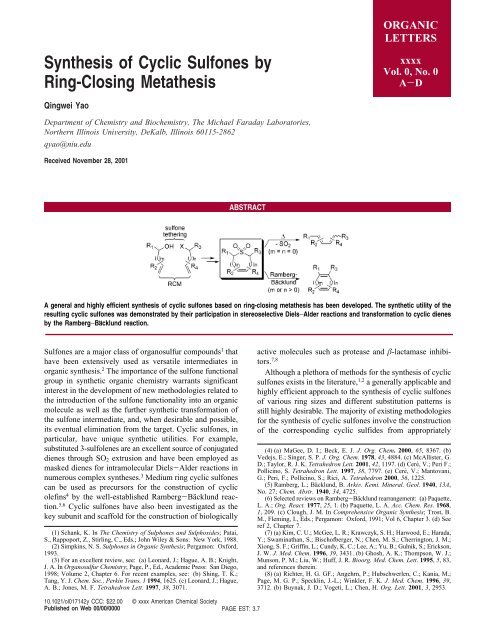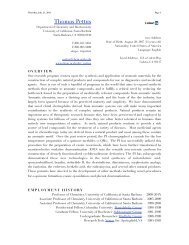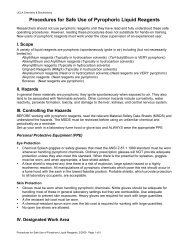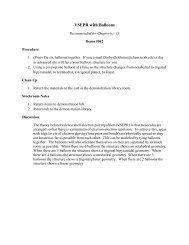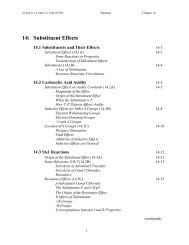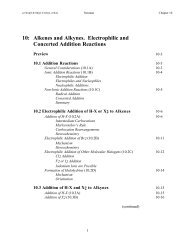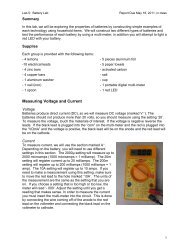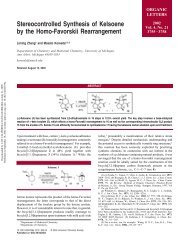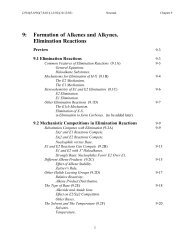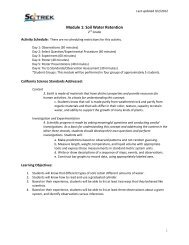Synthesis of Cyclic Sulfones by Ring-Closing Metathesis
Synthesis of Cyclic Sulfones by Ring-Closing Metathesis
Synthesis of Cyclic Sulfones by Ring-Closing Metathesis
Create successful ePaper yourself
Turn your PDF publications into a flip-book with our unique Google optimized e-Paper software.
<strong>Synthesis</strong> <strong>of</strong> <strong>Cyclic</strong> <strong>Sulfones</strong> <strong>by</strong><br />
<strong>Ring</strong>-<strong>Closing</strong> <strong>Metathesis</strong><br />
Qingwei Yao<br />
Department <strong>of</strong> Chemistry and Biochemistry, The Michael Faraday Laboratories,<br />
Northern Illinois UniVersity, DeKalb, Illinois 60115-2862<br />
qyao@niu.edu<br />
Received November 28, 2001<br />
ABSTRACT<br />
A general and highly efficient synthesis <strong>of</strong> cyclic sulfones based on ring-closing metathesis has been developed. The synthetic utility <strong>of</strong> the<br />
resulting cyclic sulfones was demonstrated <strong>by</strong> their participation in stereoselective Diels−Alder reactions and transformation to cyclic dienes<br />
<strong>by</strong> the Ramberg−Ba1cklund reaction.<br />
<strong>Sulfones</strong> are a major class <strong>of</strong> organosulfur compounds 1 that<br />
have been extensively used as versatile intermediates in<br />
organic synthesis. 2 The importance <strong>of</strong> the sulfone functional<br />
group in synthetic organic chemistry warrants significant<br />
interest in the development <strong>of</strong> new methodologies related to<br />
the introduction <strong>of</strong> the sulfone functionality into an organic<br />
molecule as well as the further synthetic transformation <strong>of</strong><br />
the sulfone intermediate, and, when desirable and possible,<br />
its eventual elimination from the target. <strong>Cyclic</strong> sulfones, in<br />
particular, have unique synthetic utilities. For example,<br />
substituted 3-sulfolenes are an excellent source <strong>of</strong> conjugated<br />
dienes through SO2 extrusion and have been employed as<br />
masked dienes for intramolecular Diels-Alder reactions in<br />
numerous complex syntheses. 3 Medium ring cyclic sulfones<br />
can be used as precursors for the construction <strong>of</strong> cyclic<br />
olefins 4 <strong>by</strong> the well-established Ramberg-Bäcklund reaction.<br />
5,6 <strong>Cyclic</strong> sulfones have also been investigated as the<br />
key subunit and scaffold for the construction <strong>of</strong> biologically<br />
(1) Schank, K. In The Chemistry <strong>of</strong> Sulphones and Sulphoxides; Patai,<br />
S., Rappoport, Z., Stirling, C., Eds.; John Wiley & Sons: New York, 1988.<br />
(2) Simpkins, N. S. Sulphones in Organic <strong>Synthesis</strong>; Pergamon: Oxford,<br />
1993.<br />
(3) For an excellent review, see: (a) Leonard, J.; Hague, A. B.; Knight,<br />
J. A. In Organosulfur Chemistry; Page, P., Ed., Academic Press: San Diego,<br />
1998; Volume 2, Chapter 6. For recent examples, see: (b) Shing, T. K.;<br />
Tang, Y. J. Chem. Soc., Perkin Trans. 1 1994, 1625. (c) Leonard, J.; Hague,<br />
A. B.; Jones, M. F. Tetrahedron Lett. 1997, 38, 3071.<br />
10.1021/ol017142y CCC: $22.00 © xxxx American Chemical Society<br />
Published on Web 00/00/0000<br />
PAGE EST: 3.7<br />
ORGANIC<br />
LETTERS<br />
xxxx<br />
Vol. 0, No. 0<br />
A-D<br />
active molecules such as protease and �-lactamase inhibitors.<br />
7,8<br />
Although a plethora <strong>of</strong> methods for the synthesis <strong>of</strong> cyclic<br />
sulfones exists in the literature, 1,2 a generally applicable and<br />
highly efficient approach to the synthesis <strong>of</strong> cyclic sulfones<br />
<strong>of</strong> various ring sizes and different substitution patterns is<br />
still highly desirable. The majority <strong>of</strong> existing methodologies<br />
for the synthesis <strong>of</strong> cyclic sulfones involve the construction<br />
<strong>of</strong> the corresponding cyclic sulfides from appropriately<br />
(4) (a) MaGee, D. I.; Beck, E. J. J. Org. Chem. 2000, 65, 8367. (b)<br />
Vedejs, E.; Singer, S. P. J. Org. Chem. 1978, 43, 4884. (c) McAllister, G.<br />
D.; Taylor, R. J. K. Tetrahedron Lett. 2001, 42, 1197. (d) Cerè, V.; Peri F.;<br />
Pollicino, S. Tetrahedron Lett. 1997, 38, 7797. (e) Cerè, V.; Mantovani,<br />
G.; Peri, F.; Pollicino, S.; Rici, A. Tetrahedron 2000, 56, 1225.<br />
(5) Ramberg, L.; Bäcklund, B. ArkiV. Kemi. Mineral. Geol. 1940, 13A,<br />
No. 27; Chem. Abstr. 1940, 34, 4725.<br />
(6) Selected reviews on Ramberg-Bäcklund rearrangement: (a) Paquette,<br />
L. A.; Org. React. 1977, 25, 1. (b) Paquette, L. A. Acc. Chem. Res. 1968,<br />
1, 209. (c) Clough, J. M. In ComprehensiVe Organic <strong>Synthesis</strong>; Trost, B.<br />
M., Fleming, I., Eds.; Pergamon: Oxford, 1991; Vol 6, Chapter 3. (d) See<br />
ref 2, Chapter 7.<br />
(7) (a) Kim, C. U.; McGee, L. R.; Krawczyk, S. H.; Harwood, E.; Harada,<br />
Y.; Swaminathan, S.; Bisch<strong>of</strong>berger, N.; Chen, M. S.; Cherrington, J. M.;<br />
Xiong, S. F.; Griffin, L.; Cundy, K. C.; Lee, A.; Yu, B.; Gulnik, S.; Erickson,<br />
J. W. J. Med. Chem. 1996, 39, 3431. (b) Ghosh, A. K.; Thompson, W. J.;<br />
Munson, P. M.; Liu, W.; Huff, J. R. Bioorg. Med. Chem. Lett. 1995, 5, 83,<br />
and references therein.<br />
(8) (a) Richter, H. G. GF.; Angehrn, P.; Hubschwerlen, C.; Kania, M.;<br />
Page, M. G. P.; Specklin, J.-L.; Winkler, F. K. J. Med. Chem. 1996, 39,<br />
3712. (b) Buynak, J. D.; Vogeti, L.; Chen, H. Org. Lett. 2001, 3, 2953.
functionalized precursors that <strong>of</strong>ten require tedious multistep<br />
manipulations, followed <strong>by</strong> oxidation <strong>of</strong> the sulfides to<br />
sulfones. In this Letter, we describe a novel and versatile<br />
strategy for the synthesis <strong>of</strong> cyclic sulfones based on the<br />
ring-closing metathesis (RCM) <strong>of</strong> acyclic sulfones which can<br />
be readily prepared from alkenyl alcohols and alkenyl halides<br />
through standard functional group transformations (vide<br />
infra), as outlined in Scheme 1.<br />
Scheme 1. RCM Approach to <strong>Cyclic</strong> <strong>Sulfones</strong><br />
The rapidly emerging olefin metathesis reaction has found<br />
many spectacular applications in organic synthesis. 9 In<br />
particular, the RCM <strong>of</strong> R,�-dienes mediated <strong>by</strong> Grubbs’<br />
ruthenium-based catalysts 1 10 and 2 11 (Figure 1) has evolved<br />
Figure 1. Grubbs Ru catalysts.<br />
into a powerful tool for the construction <strong>of</strong> carbo- and<br />
heterocyclic compounds. 9,12 The excellent functional group<br />
tolerance <strong>of</strong> 1 and 2 has allowed them to be widely applied<br />
to the synthesis <strong>of</strong> oxygen-, nitrogen-, and phosphoruscontaining<br />
cyclic molecules. However, the application <strong>of</strong><br />
RCM to the synthesis <strong>of</strong> sulfur-containing heterocycles<br />
remains very limited. Thus, both (Cy3P)2(Cl)2Ru(dCH-<br />
CHdCPh2) 13 and 1 were shown to be either unreactive or<br />
<strong>of</strong> low reactivity toward the RCM <strong>of</strong> R,�-dienes containing<br />
a sulfide moiety, 14 possibly due to the poisoning <strong>of</strong> the<br />
ruthenium catalyst <strong>by</strong> the sulfide functionality. Although the<br />
(9) Leading reviews on olefin metathesis: (a) Schuster M.; Blechert, S.<br />
Angew. Chem., Int. Ed. Engl. 1997, 36, 2036. (b) Fürstner, A. Top.<br />
Organomet. Chem. 1998, 1, 1. (c) Armstrong, S. K. J. Chem. Soc., Perkin<br />
Trans. 1 1998, 371. (d) Grubbs, R. H.; Chang, S. Tetrahedron 1998, 54,<br />
4413. (e) Pandit, U. K.; Overleeft, H. S.; Borer, B. C.; Bieräugel, H. Eur.<br />
J. Org. Chem. 1999, 959. (f) Phillips, A. J.; Abell, A. D. Aldrichimica Acta<br />
1999, 32, 75. (g) Fürstner, A. Angew. Chem., Int. Ed. 2000, 39, 3012. (h)<br />
Trnka, T. M.; Grubbs, R. H. Acc. Chem. Res. 2001, 34, 18.<br />
(10) Schwab, P.; Grubbs, R. H.; Ziller, J. W. J. Am. Chem. Soc. 1996,<br />
119, 100.<br />
(11) (a) Scholl, M.; Ding, S.; Lee, C. W.; Grubbs, R. H. Org. Lett. 1999,<br />
1, 953. For a related catalyst with similar reactivity, see: (b) Scholl, M.;<br />
Trnka, T. M.; Morgan, J. P.; Grubbs, R. H. Tetrahedron Lett. 1999, 40,<br />
2247. (c) Huang, J.; Stevens, E. D.; Nolan, S. P.; Petersen, J. F. J. Am.<br />
Chem. Soc. 1999, 121, 2674.<br />
(12) Yet, L. Chem. ReV. 2000, 100, 2963.<br />
(13) Nguyen, S. T.; Grubbs, R. H.; Ziller, J. W. J. Am. Chem. Soc. 1993,<br />
115, 9858.<br />
RCM <strong>of</strong> substrates containing a sulfonamide group has been<br />
well documented 15 and the cross metathesis <strong>of</strong> both allyl and<br />
vinyl sulfones has recently been described independently <strong>by</strong><br />
the groups <strong>of</strong> Grubbs 16 and Grela, 17 the RCM <strong>of</strong> sulfone<br />
dienes remains rare and there is only one isolated example<br />
<strong>of</strong> the formation <strong>of</strong> a six-membered cyclic sulfone in the<br />
literature. 18 The possibility <strong>of</strong> an internal Ru-sulfonyl oxygen<br />
ligation was recently proposed <strong>by</strong> Paquette et al. in their<br />
study on the macrocyclization <strong>of</strong> bicyclic sulfones. 19 Additionally,<br />
the compatibility <strong>of</strong> sulfones with Ru carbene<br />
catalysts has previously been demonstrated <strong>by</strong> Fürstner. 20<br />
We set out to examine the RCM <strong>of</strong> diallyl sulfone 3a as<br />
a test substrate (Scheme 2). Treatment <strong>of</strong> 3a with 2 mol %<br />
Scheme 2<br />
<strong>of</strong> 1 21 in CH2Cl2 (0.05 M) at reflux gave cleanly 3-sulfolene<br />
4a, which was isolated in 95% yield after chromatography.<br />
A number <strong>of</strong> structurally diverse sulfonyl dienes (3b-3i)<br />
were then prepared and their RCM performed with the results<br />
listed in Table 1. 22 The diene substrates 23 were conveniently<br />
prepared, as illustrated <strong>by</strong> the synthesis <strong>of</strong> 3b in Scheme 3,<br />
Scheme 3. Representative Procedures for the <strong>Synthesis</strong> <strong>of</strong><br />
Acyclic <strong>Sulfones</strong><br />
<strong>by</strong> a general and high-yielding protocol. This involved the<br />
Mitsunobu reaction <strong>of</strong> an alkenyl alcohol with thioacetic acid<br />
(14) (a) Armstrong, S. K.; Christie, B. A. Tetrahedron Lett. 1996, 37,<br />
9373. (b) Barrett, A. G. M.; Baugh, S. P. D.; Gibson, V. C.; Giles, M. R.;<br />
Marshall, E. L.; Procopiou, P. A. Chem. Commun. 1997, 155. (c) Shon,<br />
Y.-S.; Lee, T. R. Tetrahedron Lett. 1997, 38, 1283. (d) Fürstner, A.; Seidel,<br />
G.; Kindler, N. Tetrahedron. 1999, 55, 8255.<br />
(15) For the synthesis <strong>of</strong> cyclic sulfonamides, see: (a) Hanson, P. R.;<br />
Probst, D. A.; Robinson, R. E.; Yau, M. Tetrahedron Lett. 1999, 40, 4761.<br />
For RCM involving unsaturated sulfonamides as substates, see: (b) Visser,<br />
M. S.; Heron, N. M.; Didiuk, M. T.; Sagal, J. F.; Hoveyda, A. H. J. Am.<br />
Chem. Soc. 1996, 118, 4291. (c) Fürstner, A.; Picquet, M.; Bruneau, C.;<br />
Dixneuf, P. H. Chem. Commun. 1998, 1315. (d) Cerezo, S.; Cortés, J.;<br />
Moreno-Mañas, M.; Pleixats, R.; Roglans, A. Tetrahedron 1998, 54, 14869.<br />
(e) Paquette, L. A.; Leit, S. M. J. Am. Chem. Soc. 1999, 121, 8126. (f)<br />
Yao, Q. Angew. Chem., Int. Ed. 2000, 39, 3896.<br />
(16) Chatterjee, A. K.; Grubbs, R. H. Org. Lett. 1999, 1, 1751.<br />
B Org. Lett.
Table 1. Formation <strong>of</strong> <strong>Cyclic</strong> <strong>Sulfones</strong> <strong>by</strong> <strong>Ring</strong>-<strong>Closing</strong> <strong>Metathesis</strong> Catalyzed <strong>by</strong> Grubbs Catalysts 1 and 2<br />
a All RCM reactions were carried out in CH2Cl2 at reflux with substrate concentration and reaction time as indicated. b Refers to isolated, pure products.<br />
c Diene 3d was prepared according to the literature in footnote 24. d Diene 3i was prepared from ring-opening <strong>of</strong> allyl glycidyl ether <strong>by</strong> allyl mercaptan,<br />
silylation <strong>of</strong> the resulting alcohol, and subsequent oxidation with mCPBA, see the Supporting Information.<br />
(Ph3P, DIAD in THF), subsequent one-step conversion <strong>of</strong><br />
the thiolester to the sulfide 24 <strong>by</strong> in situ cleavage <strong>of</strong> the<br />
thiolester <strong>by</strong> KOH in MeOH, direct alkylation <strong>of</strong> the resulting<br />
thiolate with an alkenyl halide, and oxidation <strong>of</strong> the resulting<br />
sulfide with mCPBA to give the required sulfone.<br />
(17) Grela, K.; Bieniek, M. Tetrahedron Lett. 2001, 38, 6425.<br />
(18) Miller, J. F.; Termin, A.; Koch, K.; Piscopio, A. D. J. Org. Chem.<br />
1998, 63, 3158.<br />
(19) Paquette, L. A.; Fabris, F.; Tae, J.; Gallucci, J. C.; H<strong>of</strong>ferberth, J.<br />
E. Am. Chem. Soc. 2000, 122, 3391.<br />
(20) (a) Fürstner, A.; Gastner, T.; Weintritt, H. J. Org. Chem. 1999, 64,<br />
2361. (b) Fürstner, A.; Ackermann, L. Chem. Commun. 1999, 95.<br />
(21) Catalysts 1 and 2 were purchased from Strem Chemicals, Inc.<br />
As shown in Table 1, the new method can be applied to<br />
the synthesis <strong>of</strong> a variety <strong>of</strong> 3-sulfolenes. Formation <strong>of</strong> the<br />
2-substituted 3-sulfolene 4b proceeded smoothly with catalyst<br />
1 (entry 2), but the cyclization <strong>of</strong> substrates containing a<br />
gem-disubstituted alkene (entries 3 and 4) required the more<br />
reactive catalyst 2. 11,21 Nevertheless, the tri- and tetrasubstituted<br />
cyclic olefins 4c and 4d were formed in essentially<br />
(22) A representative procedure for the RCM is provided in the<br />
Supporting Information.<br />
(23) The known compound 3d was prepared according to ref 24.<br />
(24) Cao, X.-P.; Chan, T. L.; Chou, H.-F.; Tu, J. Chem. Commun. 1995,<br />
1297.<br />
Org. Lett. C
quantitative yield. It should be noted that the convenient<br />
synthesis <strong>of</strong> 4c points to a general and highly efficient<br />
approach to 2,4-dialkylated 3-sulfones which are known to<br />
be difficult to synthesize <strong>by</strong> existing methods. 25 Coupled with<br />
cheleotropic ring opening, this synthesis provides a rapid<br />
access to trans-1,3-disubstituted 1,3-dienes, as demonstrated<br />
<strong>by</strong> the reaction sequence shown in Scheme 4. The bicyclic<br />
Scheme 4. Sequential RCM/Stereospecific SO2 Extrusion/<br />
Diels-Alder Reaction for <strong>Synthesis</strong> <strong>of</strong> Bicyclic Compound 8<br />
compound 8 was isolated as a single diastereomer in 93%<br />
yield from 4c (directly used after the RCM <strong>of</strong> 3c as shown)<br />
<strong>by</strong> a sequence <strong>of</strong> stereospecific SO2 extrusion and an endoselective<br />
Diels-Alder reaction.<br />
We next examined the efficacy and generality <strong>of</strong> the<br />
protocol for the formation <strong>of</strong> six-membered and larger cyclic<br />
sulfones. As shown in Table 1, both the diene 3e (entry 5)<br />
and the enyne 3f (entry 6) were found to cyclize uneventfully<br />
(25) It is well-known that alkylation <strong>of</strong> 3-substituted 3-sulfolene affords<br />
only the 2,3-disubstituted derivative. For example: Shing, Y. K. M.; Tang,<br />
Y. J. Chem. Soc., Perkin Trans. 1 1994, 1025. For a general discussion <strong>of</strong><br />
this aspect <strong>of</strong> sulfolene chemistry, see ref 2.<br />
(26) Chan, T. L.; Fong, S.; Li, Y.; Man, T.-O.; Poon, C. D. Chem.<br />
Commun. 1994, 1771.<br />
with catalyst 1, whereas the formation <strong>of</strong> seven-, eight-, and<br />
nine-membered cyclic sulfones (entries 7-9) required a<br />
higher loading <strong>of</strong> the catalyst and the metathesis reaction to<br />
be performed under dilute conditions and for a longer<br />
reaction time. In all cases, however, the cyclized products<br />
were isolated in good to excellent yields.<br />
<strong>Cyclic</strong> sulfones have previously been shown to be excellent<br />
precursors for the regiospecific construction <strong>of</strong> cyclic<br />
olefins. 4 As shown in Scheme 5, both 4g and 4h underwent<br />
Scheme 5. Ramberg-Bäcklund Rearrangment <strong>of</strong> <strong>Cyclic</strong><br />
<strong>Sulfones</strong><br />
clean and high-yielding Ramberg-Bäcklund rearrangement<br />
upon treatment with Br2CF2 in the presence <strong>of</strong> KOH<br />
supported on alumina. 26<br />
In conclusion, a general and highly efficient synthesis <strong>of</strong><br />
cyclic sulfones has been developed and their synthetic utility<br />
further demonstrated <strong>by</strong> SO2 extrusion to afford a conjugated<br />
diene and <strong>by</strong> their transformation to cyclic dienes through<br />
the Ramberg-Bäcklund reaction.<br />
Acknowledgment. This work was generously supported<br />
<strong>by</strong> grants from the National Institutes <strong>of</strong> Health (GM63522)<br />
and the Petroleum Research Fund, administered <strong>by</strong> the<br />
American Chemical Society (36466-G1).<br />
Supporting Information Available: Representative procedures<br />
for the synthesis <strong>of</strong> acyclic sulfone dienes and for<br />
the RCM reaction; NMR ( 1H and 13C) and analytical data<br />
for compounds 3b-i, 4b-i, 8, 10, and 11. This material is<br />
available free <strong>of</strong> charge via the Internet at http://pubs.acs.org.<br />
OL017142Y<br />
D PAGE EST: 3.7 Org. Lett.


